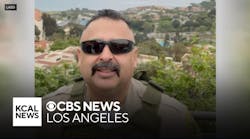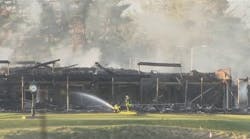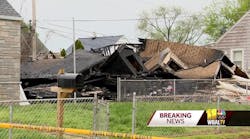In an industry with a deep commitment to volunteers – all the way back to Benjamin Franklin and the formation of the Union Fire Company – it’s a fitting tribute that federal fire service higher education committees are composed of volunteers who are helping to shape career professionalism.
The Fire and Emergency Services Higher Education (FESHE) program at the National Fire Academy (NFA) is composed of volunteers from both the fire service and academia. FESHE strives to produce academically educated fire and emergency services leaders using a curriculum derived from years of on-the-job experience and uncounted hours of committee work.
As the program progressed, committee members saw a need to standardize curriculum. As a result, they have produced core courses for both the associate’s and bachelor’s degrees. Under the umbrella of the “Professional Development Committees,” both associate’s and bachelor’s degree committee members agree that the process has been far from easy, with ponderous discussions and difficult decisions the norm.
Historical FESHE
In 2000, at FESHE II, the six model courses for the associate’s degree were identified. In 2001, groups were formed to develop skeletal outlines for the courses and volunteers were tagged to begin writing the outlines. The associate’s group of the now-called National Fire Science Degree Programs Committee spawned from this initial band of volunteers, according to Ed Kaplan, section chief for Education, Training and Partnerships at the NFA.
“The year 2001 was very much a breakout year for us,” Kaplan said. “In the addition to the development of outlines, the very first discussion and early depiction of the NPD (National Professional Development) model occurred. Jim Broman, then chair of the International Association of Fire Chiefs (IAFC) Professional Development Committee, was the intellectual force behind this. The model went through several iterations since then. We also had the first meeting with book publishers…which was the start of an incredible partnership.”
It has proved to be a successful model that is based on the empowerment of peer-driven committees to identify their respective audiences’ needs and develop products and recommendations to meet them. As committees governed under the Federal Advisory Committees Act (FACA), all recommendations are compiled in a report and then submitted to the NFA’s Board of Visitors, which then approves or sometimes modifies or adds recommendations.
Associate’s Committee
Ralph De La Ossa, associate’s committee chair and director of Public Services/professor at Long Beach City College in California, is a founding member of the associate’s committee. The retired Riverside, CA, firefighter and arson investigator was on the ground floor when at a FESHE meeting in 1998 he recalls the humble beginnings of what was to become a national standard and curriculum.
“We’ve come a long ways and it’s quite a feather in our hats and to the nation in particular – the accomplishments FESHE has made,” he said. “Prior to committee efforts at the national level, every state had its own program and its own curriculum – now the states are adopting our curriculum. Most of the people in the committees at the time were retired from the fire service and part of the academic community, so we had a lot of good discussions.”
The building construction curriculum, he pointed out, was derived from one he and his colleagues developed as instructors in California. That core course, although updated, remains a staple for the associate’s core.
“I’ve met people from all over the world at our meetings, who say having a standardized curriculum is really a benefit to the students,” De La Ossa said. “If a student moves from New Jersey to California and has taken a course that is recognized by FESHE, we recognize it and give them full credit for it.”
The standardization of curriculum in the fire service is not new in academia. It follows the model of standardized course numbers and names at many liberal art institutions nationwide. De La Ossa said he sees the future to include more standardization – even beyond education itself.
“The real big push is to get firefighters on a national registry – much as exists for nurses, paramedics and EMTs,” De La Ossa said. “It would be a huge benefit in terms of consistency and standardization. We are finding at the state level there is some resistance, yet here in California the fire marshal is really behind this. Imagine how much more professional and consistent it would be to have a national standard,” he says.
One of the outcomes of the 2000 FESHE conference was the development of the model fire science associate’s curriculum. Committee members and other participants identified six core associate’s-level courses in the model curriculum, which are:
• Building Construction for Fire Protection
• Fire Behavior and Combustion
• Fire Prevention
• Fire Protection Systems
• Principles of Emergency Services
• Principles of Fire and Emergency Services Safety and Survival
Bachelor’s/Graduate Committee
Professor Gary Noll, department chair/Emergency Services for the Utah Fire and Rescue Academy at Utah Valley University, and a bachelor’s committee member, said his committee’s work is really an extension of the associate’s committee endeavors.
“I’m part of the group that takes recommendations for curriculum and then helps standardize that across programs that offer traditional fire science education,” Noll said. “We try to standardize that process as much as possible while looking at the associate degree program courses. We try to make sure that its outcomes provide a foundation for the next level. We are here to make sure that the pieces fit together and the core courses provide a framework, a core for the bachelor’s program across the nation.”
Noll added, “Standardization is extremely difficult. One of the first problems you have is the sheer number of students. Higher education is numbers driven. Yet, the fire science industry is not that large – in my state, 80% of the firefighters are volunteers.”
Volunteers are less likely to pursue fire science higher education than career firefighters. “Further,” he said, “in fire departments there is no standardization per se. For example, in wildland firefighting or aviation firefighting, there are national standards to follow, but as far as the structural side, there are few standards.”
“We are closer to producing a unified curriculum today than we were 10 years ago due to FESHE,” Noll said. “The most difficult aspect is trying to balance the needs of a number of players: the students, the educators, the hiring authority and government entities. My opinion is that the changes are going to happen via the bottom-up model. We have a strong focus of the associate’s side with FESHE. We believe, as a lot of others believe, if students don’t receive these core FESHE courses at the associate’s level, then they’re probably not going to get them as stand-alone courses – that base educational foundation – any time in their careers.
Noll continued, “Our associate’s degree at Utah Valley University is more fire science and applied in nature. I would say the great majority of our students are traditional, not affiliated yet, and are still trying to get a job in the field. It’s just the opposite with the bachelor students who are already affiliated – they have jobs. I think that first of all the students consider the field they’re about to get into…is it really a profession? Most would agree it is. What’s interesting is that disciplines such as law, accounting and others have a standardized curriculum. If you take a course on the East Coast in law, it will look an awful lot like the same course on the West Coast. The push with FESHE is to do something similar. The strength in this profession is to standardize the curriculum. It makes it easier to transfer credits from location to location and to go from associate’s degree into a bachelor’s program courses.”
Gary Kistner, bachelor’s committee chair, and program coordinator for Fire Service and director of Graduate Studies at Southern Illinois University/Carbondale, said much discussion went into the creation of the core bachelor’s curriculum.
“One of the activities of the bachelor’s committee involves looking at the syllabus, the outcomes and other aspects of a course to make sure that it meets the requirements of the corresponding FESHE course,” Kistner said.
These courses take aim at managerial-level positions in the fire service, unlike the associate’s courses, which tend to serve firefighters and first-tier fire officers. The core courses are:
• Political and Legal Foundations of Fire Protection
• Applications of Fire Research
• Fire Prevention Organization and Management
• Personnel Management for the Fire and Emergency Services
• Fire and Emergency Services Administration
• Community Risk Reduction for the Fire and Emergency Services
“I would describe them as core courses that would be needed by a chief officer,” Kistner said. “These are courses that a fire department would say as someone moves into the officers ranks, ‘This is what we’re looking for.’ We worked quite closely with fire departments to ensure that when a student progresses through this program that it is a worthwhile endeavor. Using the National Professional Development matrix, these core courses are part of the matrix for Fire Officer III. Having the development matrix helped, but having experts in the fire service assisting us, knowing what they do and their experience really helped. This was not a bunch of educators sitting around the table saying what we wanted to see, but we used the input from those who have spent a career in the fire service as a basis for creating these core courses.”
As for the future, Kistner said, “We’re looking at what a master’s degree should look like. I think we pretty much have that nailed down in that the committee decided as a whole; it will not limit a master’s degree to specific courses. In the master’s program, courses must be recognizable by community leaders so that they know the individual has a solid background in various disciplines. The fire service itself has been the driving force for standardization of curriculum at the college level.” Much of it had to do with duplication of courses, course names and course descriptions, which only led to a certain amount of confusion, he added.
Committee member Dr. Larry Collins, who is department chair for Safety, Security and Emergency Management at Eastern Kentucky University, said the associate’s core is of inestimable value to the bachelor’s curriculum.
The associate’s core came first and it seemed to be a normal progression for the courses that all committee members could agree upon and it sets the pace for the bachelor’s program,” he said. “I think the bachelor’s curriculum is of particular value in fire admin…and that’s good. But people get into a chief’s position through a lot of different routes: prevention, investigation, human resources or logistics. I think the biggest success with FESHE is that we have more people pursuing degrees. I don’t know if it’s because of FESHE, but for whatever reason, the bar is being raised.”
Collins continued, “Another area that’s very important is accreditation and regional accreditation – especially now with the influx of online education. I’m not sure some institutions are doing a quality job with online education. And this could hurt this delivery modality.”
And because of online delivery’s flexibility, especially with shift schedules, those institutions that are riding the profit wave versus those pursuing quality education could devalue the entire process, Collins cautioned. “The committee members pore through each of the individual classes to see exactly what’s in them,” Collins said. “Having standardized curriculum allows for the development of textbooks for these classes. Publishers are much more willing to develop a book when courses are standardized.”
Providing a different perspective, Jim Broman, retiring chief of the Lacey, WA, Fire District and a former bachelor’s committee member, said, “A lesson we keep learning over and over in our society and political activities: the different perspectives brought into the mix make a better product. A finished product seldom lines up with any one particular interest group. But it’s usually something everyone then acknowledges as better than any individual idea.”
Broman explained curriculum development as “a process piece in that all education and social development is a series of building blocks. As you build on a solid foundation and you put the next layer or course of bricks on – if it’s compatible – it strengthens the entire piece. Both from the academic perspective and from the more theoretical perspective, and from the field perspective, FESHE is more likely going to give you the content and competencies that’s going to make you successful. It might not be as glitzy as other programs, but it is the regimen or the piece you need to become complete.”
Broman said he sees the future of FESHE as keeping the curriculum relevant and current. “There is such a time lag between updating curriculum,” Broman said. “Part of that has to do with its cost; but as the industry changes, we need to stay current. Many leadership and organizational practices remained fairly constant, but there are a lot of things that are changing. I think a lot of changes today are technological in nature. It’s made certain elements of management and leadership not obsolete, but technology allows you to do more. I think another wave that will affect the fire service pretty dramatically is the whole sustainable communities – green initiatives – and how they will alter the models that fire protection engineers have designed. Because of the design concepts of the green initiative, models are coming into question. It puts prevention in flux and raises questions in the response community...FESHE needs to acknowledge this because it is a huge new development.”
Broman added, “The role of FESHE is to identify historical and dramatic forces that will affect us all without allowing the fringe issues to drive curriculum. It has significantly raised the awareness level among fire service personnel and also addressed a very serious problem of the lack of coordination and organization of college classes. It has allowed students to be more efficient and bringing courses into the online world which has made them more available. Ed Kaplan’s passion, his background, his expertise and the situation in which he was in – all have allowed a lot of good things to happen. My hope is that FESHE endures and continues to progress.”
Kaplan summarized this challenge: “In an effort to acquire an associate’s or bachelor’s degree or their next desired level of certification, fire service personnel typically accumulate college transcripts with unnecessary courses and dozens of training certificates. During this typical process of professional development, duplications of effort are common and desired certifications or degrees delayed. What is the cause of this problem? Bluntly stated, the providers of training, education and certification do not always collaborate for the good of the end-user, or the firefighter and fire officer. It is an inefficient and costly system of professional development that is unsustainable during these difficult economic times.”
Just as Benjamin Franklin empowered the likes of George Washington, Samuel Adams and Thomas Jefferson to become volunteer fighters, he saw education as a civic tool too. He believed the value of higher education was a means of delivering more effective public service. FESHE today seeks the same results.





